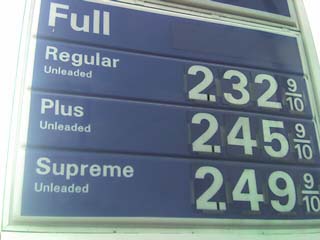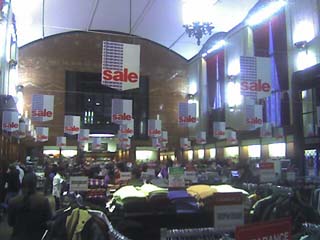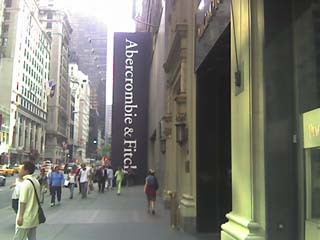consumer
 |
Not solely driven by supply and demand in an age of near-perfect information, convenience, and undetermined influences that shape the unmeasured intrinsic values we place on goods, an equilibrium price is much harder to arrive at between seller and buyer. And unlike a market where buyers and sellers have direct contact with each other to agree on prices, large, sprawling, corporate retailers often don't exploit their direct contact to consumers, preferring instead to control variable costs (1) before altering their prices at the point of sale.
And thanks to hyper-competition, the large corporate retailer no longer commands the pricing power that they sized up to maintain since consumers always have an alternative today, including putting off a purchase. Regrettably, retailers can't simply refuse to sell if customers simply refuse pay for things at the available prices.
So, How Does Stuff Keep Selling?
Believe it or not, consumers don't utilize every scrap of information available to them. This is often attributed to their lack of access to the information; but it may also be attributed to their lack of resourcefulness in locating this information, then implementing it to their advantage.
This inability to process information is what permits retailers to part consumers with their money, and is indicative of an erroneous twist in how "value" is traditionally thought of: thanks to Adam Smith's early correlation between value and how much labor is used in the making of a good, learning and analysis - those intangible, invisible hands of the economy - are often undervalued, even today, and thus, underutilized by buyers (2).
 |
Recently, (when it was convenient for me to do so,) I purchased the latest Harry Potter book for $18.45 including tax. Aware of its published price, its inordinately large supply, and extensive distribution network all competing for my dollar, when the clerk at the book retailer I purchased it from told me the price, I recognized immediately that this was an extremely reasonable price and purchased the book on the spot. An owner at the book behind me in line was wide-eyed-shocked, as was a friend at dinner that evening, for both had unwittingly paid more for their books. This is not the market in disarray; it's uninformed buyers, who simply undervalued the (source of and) information I possessed and paid "the price". (3) But more incredibly, despite the law of supply and demand (prices were widely discounted), buyers still paid higher prices, meaning that retailers who discounted, left money on the table; and Scholastic, the publisher, goofed by saturating the market (a common problem in any entertainment-related business, due to their dreadful understanding of the intrinsic value consumers place on their goods) (4).
Returning for a moment to those thrifty drivers scavenging for the cheapest gasoline, gas retailers have resorted to Perfect Economy 101 to offset the dual blows of universal knowledge of prices and convenience in their industry: improving customer experience. Tactics include speedier transaction times, friendlier staff, and even convenience stores on premises. The unfortunate reality of this all is that when pricing isn't in favor of big oil retailers (like it is today), the cost of pumping the same gas when oil prices fall is higher for retailers who increase their level of customer service to prevent defection. Thus, the long-established formula for arriving at a price (fixed cost + variable cost + desired margin = price) is no longer helpful to a retailer.
Back to Basics: Letting the Customer Tell You What They Want to Pay
In 2003, al berrios & co. analyzed urban sentiments towards pricing in apparel (5); in 2004, we analyzed youth sentiments towards retailers (6); and in 2005, we analyzed member sentiments towards their gyms (7); and in each case, our findings clearly anticipated or revealed insights previously inferred solely from sales data - with much less data than normal - utilizing our iResearch methodology. The implications are simple, yet profound:
- retailers no longer need to try and error to gather historical performance;
- they no longer need to waste resources building distribution networks, with intermediary layers between them and their customers;
- they no longer need sophisticated software that's too cumbersome to input data into;
- they can rely less on competitors' pricing moves to make their own moves; and
- they definitely don't need to solely rely on store manager "gut" feelings to price locally.
With our software-less, easily-deployable, innovative methodology to capture behaviors, (previously only available to academics working on massive, costly, irrelevant-to-you, experiments) we can learn exactly what consumers want to pay for your goods and services, before you even invest a single cent in development. Best of all, the methodology speaks in nominal terms - what you see is what you get - without all of that highfalutin, confounding, gobbledygook that researchers expound to extrapolate large meaning from small results.
#1
We first noticed the possibilities during an engagement for apparel company The Timberland Company. They quietly developed a new product and prior to wide distribution, wanted awareness and "unofficial" feedback from a target group they were previously unsure how to address. Without sampling the product, we asked random consumers online to look at a single image of the product and answer a few short questions such as what they thought, would they buy and where, and how much would they pay for it. Based on Timberland's name recognition among this target audience, the consumer's familiarity with the core product's attributes, and our clients efforts to generate buzz for the product, they actually communicated to us their personal intrinsic value for the product, which our team subsequently narrowed down. Not only was our suggested price range utilized at launch (whether this was the result of our advice is unknown), but it was one of the most successful product launches in Timberland's history.
#2
Last year, in anticipation of a retail conference featuring major teen retailers, we conducted a study to evaluate who the top players really are. Teens not only told us Wal-Mart has more sway over them than Hot Topic, Aero, or A+F, but the reason had nothing to do with the latter's prices. In fact, when it comes to pricing, goods targeting teens appear to be inelastic, or a change in prices causes little to no change in volume sold. A tremendous insight indeed, considering retailers price goods based on average dollar amount teens bring to malls (~$40). In fact, despite knowing teens are fairly irrational, they price rationally, literally leaving money on the counter.
 |
#3
This year, we assessed consumer interest in joining gyms in an effort to explore areas commonly perceived to be examples of irrational consumer spending. What we found was astounding, as consumers were quite rational in their decisions to join fitness clubs; it was in fact gym management who were irrational. You see, their entire revenue model depends on recurring fees, even though this model is severely flawed. Rather than change the model, they've become hooked on monthly membership dues. Consumers, as clearly expressed in the sentiments we collected, prefer per visit, per day, per use fees, as they are well aware that they don't go to the gym as often as they'd like. But they don't have a choice, so they are typically thought to be irrational by observers. Based on factors like availability of trainers, equipment, and attractive crowd, consumers offered a full spectrum of how much they value their experience at the gym.
In all three examples,
we knew exactly what buyers wanted, presenting us with an extra variable - their
intrinsic value of a good or service - to make the pricing equation even more
accurate. The benefits to the retailer are crystal clear: now, consumer reactions
to price changes are predictable, and thus, not without a measure of control.
Write to Al Berrios
at editor@alberrios.com
Top
Footnotes
(1) Such as reducing vendor costs with efficiency consulting; reducing the cost
of raw materials by hedging supplier contracts to lock in prices over extended
periods of time; volume buying for discounts; and multi-supplier bidding to
optimize costs to retailer.
(2) Education is Bad for the Economy
(3) There is still something to be said (in another report, preferably) for the consumer who has unlimited time to return their merchandise to repurchase it elsewhere at the discounted price, but, luckily, that's a small portion of any retailer's customer base. The larger risk is really the effects of the perception that a retailer is "ripping" off the customer, which may yet be felt in the future.
(4) The Behavioral Economic Impact of Entertainment
(5) Analysis of the Non-Athletic Footwear Segment Consumer
(7) The
Fitness Club Industry Business Model is Broken and Here's Why
Top
Related alberrios.com Sections
- Retail
reports
- Pricing Strategies
Disclaimer:
The recommendations, commentary and opinions published herein are based on
public information sometimes referenced via hyperlinks. Any similarities or
likeness to any ideas or commentary from any other sources not referenced
is purely coincidental. al berrios & co. cannot control any results occurring
from advice obtained from this publication nor any opinion(s) conveyed by
any reader of this publication.
(c) 2005. All Rights Reserved. al berrios & company, inc. Published
by al berrios & co. This Report may not be reproduced or redistributed
in any form without written permission from al berrios & co., subject
to penalty.